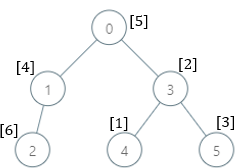原文链接: https://leetcode-cn.com/problems/smallest-missing-genetic-value-in-each-subtree
英文原文
There is a family tree rooted at 0 consisting of n nodes numbered 0 to n - 1. You are given a 0-indexed integer array parents, where parents[i] is the parent for node i. Since node 0 is the root, parents[0] == -1.
There are 105 genetic values, each represented by an integer in the inclusive range [1, 105]. You are given a 0-indexed integer array nums, where nums[i] is a distinct genetic value for node i.
Return an array ans of length n where ans[i] is the smallest genetic value that is missing from the subtree rooted at node i.
The subtree rooted at a node x contains node x and all of its descendant nodes.
Example 1:

Input: parents = [-1,0,0,2], nums = [1,2,3,4] Output: [5,1,1,1] Explanation: The answer for each subtree is calculated as follows: - 0: The subtree contains nodes [0,1,2,3] with values [1,2,3,4]. 5 is the smallest missing value. - 1: The subtree contains only node 1 with value 2. 1 is the smallest missing value. - 2: The subtree contains nodes [2,3] with values [3,4]. 1 is the smallest missing value. - 3: The subtree contains only node 3 with value 4. 1 is the smallest missing value.
Example 2:

Input: parents = [-1,0,1,0,3,3], nums = [5,4,6,2,1,3] Output: [7,1,1,4,2,1] Explanation: The answer for each subtree is calculated as follows: - 0: The subtree contains nodes [0,1,2,3,4,5] with values [5,4,6,2,1,3]. 7 is the smallest missing value. - 1: The subtree contains nodes [1,2] with values [4,6]. 1 is the smallest missing value. - 2: The subtree contains only node 2 with value 6. 1 is the smallest missing value. - 3: The subtree contains nodes [3,4,5] with values [2,1,3]. 4 is the smallest missing value. - 4: The subtree contains only node 4 with value 1. 2 is the smallest missing value. - 5: The subtree contains only node 5 with value 3. 1 is the smallest missing value.
Example 3:
Input: parents = [-1,2,3,0,2,4,1], nums = [2,3,4,5,6,7,8] Output: [1,1,1,1,1,1,1] Explanation: The value 1 is missing from all the subtrees.
Constraints:
n == parents.length == nums.length2 <= n <= 1050 <= parents[i] <= n - 1fori != 0parents[0] == -1parentsrepresents a valid tree.1 <= nums[i] <= 105- Each
nums[i]is distinct.
中文题目
有一棵根节点为 0 的 家族树 ,总共包含 n 个节点,节点编号为 0 到 n - 1 。给你一个下标从 0 开始的整数数组 parents ,其中 parents[i] 是节点 i 的父节点。由于节点 0 是 根 ,所以 parents[0] == -1 。
总共有 105 个基因值,每个基因值都用 闭区间 [1, 105] 中的一个整数表示。给你一个下标从 0 开始的整数数组 nums ,其中 nums[i] 是节点 i 的基因值,且基因值 互不相同 。
请你返回一个数组 ans ,长度为 n ,其中 ans[i] 是以节点 i 为根的子树内 缺失 的 最小 基因值。
节点 x 为根的 子树 包含节点 x 和它所有的 后代 节点。
示例 1:

输入:parents = [-1,0,0,2], nums = [1,2,3,4] 输出:[5,1,1,1] 解释:每个子树答案计算结果如下: - 0:子树包含节点 [0,1,2,3] ,基因值分别为 [1,2,3,4] 。5 是缺失的最小基因值。 - 1:子树只包含节点 1 ,基因值为 2 。1 是缺失的最小基因值。 - 2:子树包含节点 [2,3] ,基因值分别为 [3,4] 。1 是缺失的最小基因值。 - 3:子树只包含节点 3 ,基因值为 4 。1是缺失的最小基因值。
示例 2:

输入:parents = [-1,0,1,0,3,3], nums = [5,4,6,2,1,3] 输出:[7,1,1,4,2,1] 解释:每个子树答案计算结果如下: - 0:子树内包含节点 [0,1,2,3,4,5] ,基因值分别为 [5,4,6,2,1,3] 。7 是缺失的最小基因值。 - 1:子树内包含节点 [1,2] ,基因值分别为 [4,6] 。 1 是缺失的最小基因值。 - 2:子树内只包含节点 2 ,基因值为 6 。1 是缺失的最小基因值。 - 3:子树内包含节点 [3,4,5] ,基因值分别为 [2,1,3] 。4 是缺失的最小基因值。 - 4:子树内只包含节点 4 ,基因值为 1 。2 是缺失的最小基因值。 - 5:子树内只包含节点 5 ,基因值为 3 。1 是缺失的最小基因值。
示例 3:
输入:parents = [-1,2,3,0,2,4,1], nums = [2,3,4,5,6,7,8] 输出:[1,1,1,1,1,1,1] 解释:所有子树都缺失基因值 1 。
提示:
n == parents.length == nums.length2 <= n <= 105- 对于
i != 0,满足0 <= parents[i] <= n - 1 parents[0] == -1parents表示一棵合法的树。1 <= nums[i] <= 105nums[i]互不相同。
通过代码
高赞题解
解法一:启发式合并
遍历整棵树,统计每棵子树包含的基因值集合,以及缺失的最小基因值(记作 $\textit{mex}$)。合并基因值集合时,总是从小的往大的合并(类似并查集的按秩合并),同时更新当前子树的 $\textit{mex}$ 的最大值。合并完成后再不断自增子树的 $\textit{mex}$ 直至其不在基因值集合中。
这一方法同时也适用于有相同基因值的情况。
时间复杂度:$O(n\log n)$。证明。
func smallestMissingValueSubtree(parents []int, nums []int) []int {
n := len(parents)
g := make([][]int, n)
for w := 1; w < n; w++ {
v := parents[w]
g[v] = append(g[v], w)
}
mex := make([]int, n)
var f func(int) map[int]bool
f = func(v int) map[int]bool {
inSet := map[int]bool{}
mex[v] = 1
for _, w := range g[v] {
s := f(w)
// 启发式合并:保证从小的集合合并到大的集合
if len(s) > len(inSet) {
inSet, s = s, inSet
}
for x := range s {
inSet[x] = true
}
if mex[w] > mex[v] {
mex[v] = mex[w]
}
}
inSet[nums[v]] = true
for inSet[mex[v]] {
mex[v]++ // 不断自增直至 mex[v] 不在集合中
}
return inSet
}
f(0)
return mex
}解法二:利用无重复基因值的性质
由于没有重复基因,若存在一个节点 $x$,其基因值为 $1$,那么从 $x$ 到根这一条链上的所有节点,由于子树包含 $x$,其 $\textit{mex}$ 均大于 $1$,而其余不在链上的节点,由于子树不包含 $x$,故其 $\textit{mex}$ 均为 $1$。因此,我们只需要计算在这条链上的节点的 $\textit{mex}$ 值。
我们可以从 $x$ 出发,顺着父节点往根走,同时收集当前子树下的所有基因值,然后再不断自增子树的 $\textit{mex}$ 直至其不在基因值集合中。
时间复杂度:$O(n)$。
func smallestMissingValueSubtree(parents []int, nums []int) []int {
n := len(parents)
mex := make([]int, n)
for i := range mex {
mex[i] = 1
}
g := make([][]int, n)
for w := 1; w < n; w++ {
v := parents[w]
g[v] = append(g[v], w)
}
inSet := map[int]bool{}
var f func(int)
f = func(v int) {
inSet[nums[v]] = true // 收集基因值
for _, w := range g[v] {
if !inSet[nums[w]] { // 避免重复访问节点
f(w)
}
}
}
// 找到基因值等于 1 的节点 x
x := -1
for i, v := range nums {
if v == 1 {
x = i
break
}
}
// x 顺着父节点往上走
for cur := 2; x >= 0; x = parents[x] {
f(x)
for inSet[cur] {
cur++ // 不断自增直至不在基因值集合中
}
mex[x] = cur
}
return mex
}统计信息
| 通过次数 | 提交次数 | AC比率 |
|---|---|---|
| 1995 | 5038 | 39.6% |
提交历史
| 提交时间 | 提交结果 | 执行时间 | 内存消耗 | 语言 |
|---|




